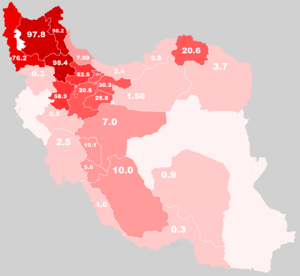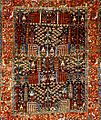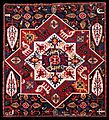Iranian Azerbaijanis facts for kids
Iranian Azerbaijanis (Azerbaijani: ایران آذربایجانلیلاری, İran azərbaycanlıları) are the ethnic Azerbaijani people of Iran. They are the second largest ethnic group in Iran after the Persians. Most Iranian Azerbaijanis live in the region of Iranian Azerbaijan of northwestern Iran, however they also live in large numbers in the capital Tehran and across the rest of the country. Iranian Azerbaijani communities are also found in the United States of America, Germany, Canada, Turkey, and France. About 98% of Iranian Azerbaijanis are Muslim and about 90% of Iranian Azerbaijanis are Shi'a.
Contents
Art
Living in cross-road of many civilizations, Azeris artisans have developed a rich tradition of decorative arts including rugs, lace, printed textiles, jewelry, vessels made of copper, engraved metals, wooden articles and ceramics. Among these, carpet weaving stands out as the acme of Azeri art.
Carpet weaving
Tabriz is one of the main centers of carpet weaving in Iran. At present 40% of Iranian carpet exports are originated from Tabriz. These carpets are generally known as Tabriz rugs. Another carpet weaving center is Ardebil, which, despite being overshadowed by Tabriz in recent years, has produced the finest carpets in past. Two most famous Iranian rugs in the world had been woven in Ardebil in 1540. One is hung in the Victoria and Albert Museum in London, and the other is in the Los Angeles County Museum of Arts. These carpets have silk warps and contain over thirty million knots.
Images for kids
-
Mirza Fatali Akhundzade (also known as Akhundov), celebrated ethnic Azerbaijani author, playwright, philosopher, and founder of modern literary criticism. Born in Nukha to a family originally hailing from Iranian Azerbaijan.
-
Sattar Khan, Iranian Azerbaijani, was a key figure in the Iranian Constitutional Revolution and is held in great esteem by many Iranians.
-
Iran's supreme leader Ali Khamenei, as the highest-ranking official in Iran, is an Iranian Azerbaijani.
See also
 In Spanish: Azeríes iraníes para niños
In Spanish: Azeríes iraníes para niños










